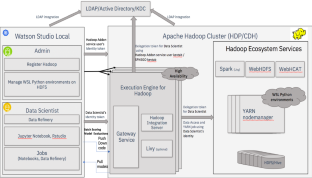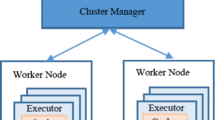Abstract
One of the most challenging issues in the big data research area is the inability to process a large volume of information in a reasonable time. Hadoop and Spark are two frameworks for distributed data processing. Hadoop is a very popular and general platform for big data processing. Because of the in-memory programming model, Spark as an open-source framework is suitable for processing iterative algorithms. In this paper, Hadoop and Spark frameworks, the big data processing platforms, are evaluated and compared in terms of runtime, memory and network usage, and central processor efficiency. Hence, the K-nearest neighbor (KNN) algorithm is implemented on datasets with different sizes within both Hadoop and Spark frameworks. The results show that the runtime of the KNN algorithm implemented on Spark is 4 to 4.5 times faster than Hadoop. Evaluations show that Hadoop uses more sources, including central processor and network. It is concluded that the CPU in Spark is more effective than Hadoop. On the other hand, the memory usage in Hadoop is less than Spark.






















Similar content being viewed by others
References
Chen M, Mao S, Liu Y (2014) Big data: a survey. Mob Netw Appl 19(2):171–209
Wu C, Zapevalova E, Chen Y, Zeng D, Liu F (2018) Optimal model of continuous knowledge transfer in the big data environment. Computr Model Eng Sci 116(1):89–107
Dean J, Ghemawat S (2008) MapReduce: simplified data processing on large clusters. Commun ACM 51(1):107–113
Tang Z, Jiang L, Yang L, Li K, Li K (2015) CRFs based parallel biomedical named entity recognition algorithm employing MapReduce framework. Clust Comput 18(2):493–505
Tang Z, Liu K, Xiao J, Yang L, Xiao Z (2017) A parallel k-means clustering algorithm based on redundance elimination and extreme points optimization employing MapReduce. Concurr Comput Pract Exp 29(20):e4109
Zaharia M, Chowdhury M, Das T, Dave A, Ma J, McCauly M, Michael J, Franklin SS, Stoica I (2012) Resilient distributed datasets: a fault-tolerant abstraction for in-memory cluster computing. In: Presented as Part of the 9th {USENIX} Symposium on Networked Systems Design and Implementation ({NSDI} 12), pp 15–28
Cobb AN, Benjamin AJ, Huang ES, Kuo PC (2018) Big data: more than big data sets. Surgery 164(4):640–642
Qin SJ, Chiang LH (2019) Advances and opportunities in machine learning for process data analytics. Comput Chem Eng 126:465–473
Jordan MI, Mitchell TM (2015) Machine learning: trends, perspectives, and prospects. Science 349(6245):255–260
Wu C, Zapevalova E, Li F, Zeng D (2018) Knowledge structure and its impact on knowledge transfer in the big data environment. J Internet Technol 19(2):581–590
Zhou L, Pan S, Wang J, Vasilakos AV (2017) Machine learning on big data: opportunities and challenges. Neurocomputing 237:350–361
Russell SJ, Norvig P (2016) Artificial intelligence: a modern approach. Pearson Education Limited, Kuala Lumpur
Aziz K, Zaidouni D, Bellafkih M (2018) Real-time data analysis using Spark and Hadoop. In: 2018 4th International Conference on Optimization and Applications (ICOA). IEEE, pp 1–6
Hazarika AV, Ram GJSR, Jain E (2017) Performance comparison of Hadoop and spark engine. In: 2017 International Conference on I-SMAC (IoT in Social, Mobile, Analytics and Cloud)(I-SMAC). IEEE, pp 671–674
Gopalani S, Arora R (2015) Comparing apache spark and map reduce with performance analysis using k-means. Int J Comput Appl 113(1):8–11
Wang H, Wu B, Yang S, Wang B, Liu Y (2014) Research of decision tree on yarn using mapreduce and Spark. In: Proceedings of the 2014 World Congress in Computer Science, Computer Engineering, and Applied Computing, pp 21–24
Liang F, Feng C, Lu X, Xu Z (2014) Performance benefits of DataMPI: a case study with BigDataBench. In: Workshop on Big Data Benchmarks, Performance Optimization, and Emerging Hardware. Springer, Cham, pp 111–123
Pirzadeh P (2015) On the performance evaluation of big data systems. Doctoral dissertation, UC Irvine
Mavridis I, Karatza H (2017) Performance evaluation of cloud-based log file analysis with Apache Hadoop and Apache Spark. J Syst Softw 125:133–151
Im S, Moseley B (2019) A conditional lower bound on graph connectivity in mapreduce. arXiv preprint arXiv:1904.08954
Kodali S, Dabbiru M, Rao BT, Patnaik UKC (2019) A k-NN-based approach using MapReduce for meta-path classification in heterogeneous information networks. In: Soft Computing in Data Analytics. Springer, Singapore, pp 277–284
Li Y, Eldawy A, Xue J, Knorozova N, Mokbel MF, Janardan R (2019) Scalable computational geometry in MapReduce. VLDB J 28(4):523–548
Li F, Chen J, Wang Z (2019) Wireless MapReduce distributed computing. IEEE Trans Inf Theory 65(10):6101–6114
Liu J, Wang P, Zhou J, Li K (2020) McTAR: a multi-trigger check pointing tactic for fast task recovery in MapReduce. IEEE Trans Serv Comput. https://doi.org/10.1109/TSC.2019.2904270
Glushkova D, Jovanovic P, Abelló A (2019) Mapreduce performance model for Hadoop 2.x. Inf Syst 79:32–43
Saxena A, Chaurasia A, Kaushik N, Kaushik N (2019) Handling big data using MapReduce over hybrid cloud. In: International Conference on Innovative Computing and Communications. Springer, Singapore, pp 135–144
Kuo A, Chrimes D, Qin P, Zamani H (2019) A Hadoop/MapReduce based platform for supporting health big data analytics. In: ITCH, pp 229–235
Kumar DK, Bhavanam D, Reddy L (2020) Usage of HIVE tool in Hadoop ECO system with loading data and user defined functions. Int J Psychosoc Rehabil 24(4):1058–1062
Alnasir JJ, Shanahan HP (2020) The application of hadoop in structural bioinformatics. Brief Bioinform 21(1):96–105
Park HM, Park N, Myaeng SH, Kang U (2020) PACC: large scale connected component computation on Hadoop and Spark. PLoS ONE 15(3):e0229936
Xu Y, Wu S, Wang M, Zou Y (2020) Design and implementation of distributed RSA algorithm based on Hadoop. J Ambient Intell Humaniz Comput 11(3):1047–1053
Wang J, Li X, Ruiz R, Yang J, Chu D (2020) Energy utilization task scheduling for MapReduce in heterogeneous clusters. IEEE Trans Serv Comput. https://doi.org/10.1109/TSC.2020.2966697
Wei P, He F, Li L, Shang C, Li J (2020) Research on large data set clustering method based on MapReduce. Neural Comput Appl 32(1):93–99
Souza A, Garcia I (2020) A preemptive fair scheduler policy for disco MapReduce framework. In: Anais do XV Workshop em Desempenho de Sistemas Computacionais e de Comunicação. SBC, pp 1–12
Jang S, Jang YE, Kim YJ, Yu H (2020) Input initialization for inversion of neural networks using k-nearest neighbor approach. Inf Sci 519:229–242
Chen Y, Hu X, Fan W, Shen L, Zhang Z, Liu X et al (2020) Fast density peak clustering for large scale data based on kNN. Knowl-Based Syst 187:104824
Janardhanan PS, Samuel P (2020) Optimum parallelism in Spark framework on Hadoop YARN for maximum cluster resource. In: First International Conference on Sustainable Technologies for Computational Intelligence: Proceedings of ICTSCI 2019, vol 1045. Springer Nature, p 351
Qin Y, Tang Y, Zhu X, Yan C, Wu C, Lin D (2020) Zone-based resource allocation strategy for heterogeneous spark clusters. In: Artificial Intelligence in China. Springer, Singapore, pp 113–121
Hussain DM, Surendran D (2020) The efficient fast-response content-based image retrieval using spark and MapReduce model framework. J Ambient Intell Humaniz Comput. https://doi.org/10.1007/s12652-020-01775-9
Nguyen MC, Won H, Son S, Gil MS, Moon YS (2019) Prefetching-based metadata management in advanced multitenant Hadoop. J Supercomput 75(2):533–553
Javanmardi AK, Yaghoubyan SH, Bagherifard K et al (2020) A unit-based, cost-efficient scheduler for heterogeneous Hadoop systems. J Supercomput. https://doi.org/10.1007/s11227-020-03256-4
Guo A, Jiang A, Lin J, Li X (2020) Data mining algorithms for bridge health monitoring: Kohonen clustering and LSTM prediction approaches. J Supercomput 76(2):932–947
Cheng F, Yang Z (2019) FastMFDs: a fast, efficient algorithm for mining minimal functional dependencies from large-scale distributed data with Spark. J Supercomput 75(5):2497–2517
Kang M, Lee J (2020) Effect of garbage collection in iterative algorithms on Spark: an experimental analysis. J Supercomput. https://doi.org/10.1007/s11227-020-03150-z
Xiao W, Hu J (2020) SWEclat: a frequent itemset mining algorithm over streaming data using Spark Streaming. J Supercomput. https://doi.org/10.1007/s11227-020-03190-5
Massie M, Li B, Nicholes B, Vuksan V, Alexander R, Buchbinder J, Costa F, Dean A, Josephsen D, Phaal P, Pocock D (2012) Monitoring with Ganglia: tracking dynamic host and application metrics at scale. O’Reilly Media Inc, Newton
Whiteson D (2014) Higgs data set. https://archive.ics.uci.edu/ml/datasets/HIGGS. Accessed 2016
Harrington P (2012) Machine learning in action. Manning Publications Co, New York
Masarat S, Sharifian S, Taheri H (2016) Modified parallel random forest for intrusion detection systems. J Supercomput 72(6):2235–2258
Lai WK, Chen YU, Wu TY, Obaidat MS (2014) Towards a framework for large-scale multimedia data storage and processing on Hadoop platform. J Supercomput 68(1):488–507
Won H, Nguyen MC, Gil MS, Moon YS, Whang KY (2017) Moving metadata from ad hoc files to database tables for robust, highly available, and scalable HDFS. J Supercomput 73(6):2657–2681
Lee ZJ, Lee CY (2020) A parallel intelligent algorithm applied to predict students dropping out of university. J Supercomput 76(2):1049–1062
Sandrini M, Xu B, Volochayev R, Awosika O, Wang WT, Butman JA, Cohen LG (2020) Transcranial direct current stimulation facilitates response inhibition through dynamic modulation of the fronto-basal ganglia network. Brain Stimul 13(1):96–104
Jiang W, Fu J, Chen F, Zhan Q, Wang Y, Wei M, Xiao B (2020) Basal ganglia infarction after mild head trauma in pediatric patients with basal ganglia calcification. Clin Neurol Neurosurg 192:105706
Kowalski CW, Lindberg JE, Fowler DK, Simasko SM, Peters JH (2020) Contributing mechanisms underlying desensitization of CCK-induced activation of primary nodose ganglia neurons. Am J Physiol Cell Physiol 318:C787–C796
Author information
Authors and Affiliations
Corresponding author
Additional information
Publisher's Note
Springer Nature remains neutral with regard to jurisdictional claims in published maps and institutional affiliations.
Rights and permissions
About this article
Cite this article
Mostafaeipour, A., Jahangard Rafsanjani, A., Ahmadi, M. et al. Investigating the performance of Hadoop and Spark platforms on machine learning algorithms. J Supercomput 77, 1273–1300 (2021). https://doi.org/10.1007/s11227-020-03328-5
Published:
Issue Date:
DOI: https://doi.org/10.1007/s11227-020-03328-5




